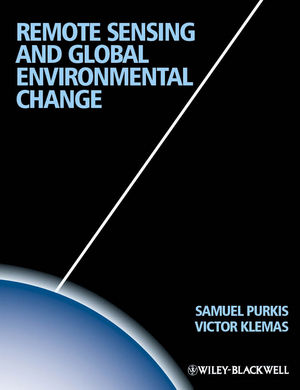Remote Sensing and Global Environmental ChangeISBN: 978-1-4051-8225-6
Paperback
384 pages
March 2011, Wiley-Blackwell
 |
||||||
Acknowledgements.
1 Introduction.
1.1 Key concepts.
2 Remote sensing basics.
2.1 Electromagnetic waves.
2.2 The electromagnetic spectrum.
2.3 Reflectance and radiance.
2.4 Atmospheric effects.
2.5 Multispectral feature recognition.
2.6 Resolution requirements.
2.7 Key concepts.
3 Remote sensors and systems.
3.1 Introduction.
3.2 Remote sensors.
3.2.1 Multispectral satellite sensors.
3.2.2 Digital aerial cameras.
3.2.3 Thermal infrared sensors.
3.2.4 Radar and microwave radiometers.
3.2.5 Laser profilers.
3.3 Remote sensing platforms.
3.3.1 Airborne platforms.
3.3.2 Medium-resolution satellites.
3.3.3 High-resolution satellites.
3.3.4 Global observation satellites.
3.4 The NASA Earth observing system.
3.5 Global Earth observation systems.
3.5.1 Global Climate Observing System.
3.5.2 Global Earth Observation System of Systems.
3.5.3 Integrated Ocean Observing System.
3.6 Existing image archives.
3.7 Key concepts.
4 Digital image analysis.
4.1 Image data format.
4.2 Image pre-processing.
4.3 Image enhancement and interpretation.
4.4 Image classification.
4.5 Image band selection.
4.6 Error assessment.
4.7 Time-series analysis and change detection.
4.8 Field sampling using GPS.
4.9 Use of Geographic Information Systems.
4.10 Key concepts.
5 Monitoring changes in global vegetation cover.
5.1 EM spectrum of vegetation.
5.2 Vegetation indices.
5.3 Biophysical properties and processes of vegetation.
5.4 Classification systems.
5.5 Global vegetation and land cover mapping programmes.
5.5.1 NASA Pathfinder global monitoring project.
5.5.2 International geosphere-biosphere program.
5.5.3 Application of new satellites and radar.
5.6 Remote sensing of vegetation as a monitor for global change.
CASE STUDY: Desertification in the African Sahel.
CASE STUDY: Deforestation of Amazonia.
5.7 Remote sensing of wetlands change.
5.8 Fire detection.
5.9 Key concepts.
6 Remote sensing of urban environments.
6.1 Urbanization.
6.2 Urban remote sensing.
6.2.1 Three-dimensional urban model generation.
6.2.2 Stereo imaging.
6.2.3 LiDAR.
6.2.4 Synthetic Aperture Radar (SAR).
6.3 Microwave sensing of subsidence.
6.4 Textural metrics.
6.5 Monitoring city growth.
6.6 Assessing the ecology of cities.
6.7 Urban climatology.
6.8 Air quality and air pollution.
6.9 Climate change as a threat to urbanization.
6.10 Key concepts.
7 Surface and ground water resources.
7.1 Remote sensing of inland water quality.
7.2 Remote sensing sediment load and pollution of inland waters.
7.3 Remote sensing non-coastal flooding.
7.4 Bathymetry of inland waters.
7.5 Mapping watersheds at the regional scale.
7.6 Remote sensing of land surface moisture.
7.7 Remote sensing of groundwater.
7.8 Key concepts.
8 Coral reefs, carbon and climate.
8.1 Introduction.
8.2 The status of the world's reefs.
8.3 Remote sensing of coral reefs.
8.4 Light, corals and water.
8.4.1 Light and the water surface.
8.4.2 Light and the water body.
8.4.3 Reflectance models for optically shallow waters.
8.4.4 Reflectance signatures of reef substrata.
8.5 Passive optical sensing.
8.6 Sensor-down versus reef-up sensing.
8.7 Spectral unmixing.
8.8 Image-derived bathymetry.
8.9 LiDAR.
8.10 Sonar.
8.11 Sub-bottom acoustic profiling.
8.12 Radar applications.
8.13 Class assemblages and the minimum mapping unit.
8.14 Change detection.
8.15 Key concepts.
9 Coastal impact of storm surges and sea level rise.
9.1 Predicting and monitoring coastal flooding.
9.2 Coastal currents and waves.
9.3 Mapping beach topography.
9.4 LiDAR bathymetry.
CASE STUDY: LiDAR application to modelling sea level rise at the Blackwater National Wildlife Refuge.
9.5 Key concepts.
10 Observing the oceans.
10.1 Introduction.
10.2 Ocean colour, chlorophyll and productivity.
10.3 Hazardous algal blooms and other pollutants.
10.4 Sea surface temperature.
CASE STUDY: Upwelling and El Niño.
10.5 Ocean salinity.
10.6 Physical ocean features.
10.6.1 Sea surface elevation and ocean currents.
10.6.2 Sea surface winds.
10.6.3 Ocean waves.
10.6.4 Oil slicks and other surface features.
10.7 Ocean observing systems.
10.8 Marine GIS.
10.9 Key concepts.
11 Monitoring Earth's atmosphere.
11.1 The status of Earth's atmosphere.
11.2 Atmospheric remote sensing.
11.3 The 'A- Train' satellite constellation.
11.3.1 Dancing on the A- Train.
11.4 Remote sensing atmospheric temperature.
11.5 Atmospheric remote sensing of ozone.
11.6 Atmospheric remote sensing of carbon dioxide.
11.7 Remote sensing atmospheric dust.
CASE STUDY: Spaceborne monitoring of African dust events.
11.8 Clouds.
11.9 Forecasting Earth's atmosphere.
11.10 Atmospheric models and reality.
11.11 Hurricanes.
CASE STUDY: Hurricane Katrina.
11.12 Key concepts.
12 Observing the cryosphere.
12.1 Introduction.
12.2 The history and status of the polar ice sheets.
12.3 Ice and sea level.
12.4 Ice and climate.
12.5 Present ice loss in context.
12.6 Remote sensing of the Earth's ice sheets.
12.6.1 Passive optical and thermal remote sensing.
12.6.2 Passive microwave remote sensing.
12.6.3 Active microwave remote sensing.
12.6.4 Active optical remote sensing – ICESat.
12.7 Ice sheet mass balance.
CASE STUDY: Disintegration of the Larsen and Wilkins ice shelves.
12.8 Remote sensing permafrost.
12.9 Key concepts.
13 Effective communication of global change information using remote sensing.
13.1 Global environmental change as an interdisciplinary issue.
13.2 Effective communication through accessibility of data.
14 Looking ahead: future developments.
14.1 Emerging technologies.
14.1.1 Fusion in remote sensing.
14.1.2 Hyper-spatial satellites.
14.1.3 Hyperspectral hyper-spatial satellites.
14.2 The near future.
14.3 The more distant future.
14.4 Advanced image analysis techniques.
14.5 Looking ahead at a changing Earth.
References.
Index.



